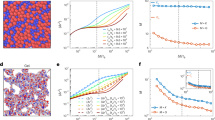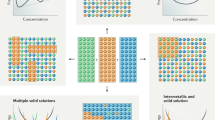Abstract
The dynamic pair distribution function (DyPDF) is an inelastic neutron scattering method that provides detailed information about the local dynamics of a crystalline material in real space. DyPDF has been applied to many systems, including ferroelectrics, superconductors and charge-density-wave materials, but a more complete adoption has been limited by lack of proper data treatment, understanding of the effects of different spectrometers and a robust method of data analysis. In this Technical Review, we provide suggestions on optimizing the use of DyPDF based on case studies of polycrystalline nickel on several inelastic neutron scattering instruments. A robust data treatment regimen is outlined to enable quantitative comparison of data across spectrometers, and an explanation and comparison of the instrumental effects are presented. We aim to show that, by a careful choice of instrument and experimental conditions, DyPDF can serve as a routine real-space complement to traditional local vibrational probes such as infrared and Raman spectroscopy.
Key points
-
The dynamic pair distribution function is a robust inelastic neutron scattering method that allows for the real-space correlation of atomic displacements.
-
The energy resolution in DyPDF depends on instrument configuration and incident energy. Such resolution information should be considered when choosing the instrument and incident energy for an experiment.
-
Background treatment, including a removal of an approximation to the single-phonon background contribution, is of the utmost importance in obtaining high-quality DyPDF data that is comparable between instruments within the energy resolution of the configuration.
-
When proper data treatment is performed, the data are quantitatively comparable across inelastic instruments within the Goldilocks principle of DyPDF.
This is a preview of subscription content, access via your institution
Access options
Access Nature and 54 other Nature Portfolio journals
Get Nature+, our best-value online-access subscription
$29.99 / 30 days
cancel any time
Subscribe to this journal
Receive 12 digital issues and online access to articles
$99.00 per year
only $8.25 per issue
Buy this article
- Purchase on Springer Link
- Instant access to full article PDF
Prices may be subject to local taxes which are calculated during checkout




Similar content being viewed by others
Change history
10 August 2023
A Correction to this paper has been published: https://doi.org/10.1038/s42254-023-00634-8
References
Gersten, J. & Smith, F. The Physics and Chemistry of Materials (Wiley, 2001).
Callister, W. & Rethwisch, D. Materials Science and Engineering: An Introduction (Wiley, 2018).
Stolow, A. & Jonas, D. M. Multidimensional snapshots of chemical dynamics. Science 305, 1575–1577 (2004).
Cho, M. Coherent two-dimensional optical spectroscopy. Chem. Rev. 108, 1331–1418 (2008).
Zanni, M. T. & Hochstrasser, R. M. Two-dimensional infrared spectroscopy: a promising new method for the time resolution of structures. Curr. Opin. Struct. Biol. 11, 516–522 (2001).
Krivanek, O. L. et al. Vibrational spectroscopy in the electron microscope. Nature 514, 209–212 (2014).
Makal, A. et al. Restricted photochemistry in the molecular solid state: structural changes on photoexcitation of Cu(i) phenanthroline metal-to-ligand charge transfer (MLCT) complexes by time-resolved diffraction. J. Phys. Chem. A 116, 3359–3365 (2012).
Kupitz, C. et al. Serial time-resolved crystallography of photosystem II using a femtosecond X-ray laser. Nature 513, 261–265 (2014).
Neutze, R. Opportunities and challenges for time-resolved studies of protein structural dynamics at X-ray free-electron lasers. Phil. Trans. R. Soc. B 369, 20130318 (2014).
Mankowsky, R. et al. Nonlinear lattice dynamics as a basis for enhanced superconductivity in YBa2Cu3O6.5. Nature 516, 71–73 (2014).
Elsaesser, T. & Woerner, M. Photoinduced structural dynamics of polar solids studied by femtosecond X-ray diffraction. Acta Crystallogr. A 66, 168–178 (2010).
Elsaesser, T. & Woerner, M. Perspective: Structural dynamics in condensed matter mapped by femtosecond X-ray diffraction. J. Chem. Phys. 140, 020901 (2014).
Bargheer, M. et al. Coherent atomic motions in a nanostructure studied by femtosecond X-ray diffraction. Science 306, 1771–1773 (2004).
Zewail, A. H. 4D ultrafast electron diffraction, crystallography, and microscopy. Annu. Rev. Phys. Chem. 57, 65–103 (2006).
Roh, J. H. et al. Multistage collapse of a bacterial ribozyme observed by time-resolved small-angle X-ray scattering. J. Am. Chem. Soc. 132, 10148–10154 (2010).
Moffat, K. The frontiers of time-resolved macromolecular crystallography: movies and chirped X-ray pulses. Faraday Discuss. 122, 65–77 (2003).
Mitchell, P. C. H., Parker, S. F., Ramirez-Cuesta, A. J. & Tomkinson, J. Vibrational Spectroscopy with Neutrons: with Applications In Chemistry, Biology, Materials Science and Catalysis (World Scientific, 2005).
Egami, T. & Billinge, S. J. L. Underneath the Bragg Peaks: Structural Analysis of Complex Materials (Elsevier, 2012).
Chupas, P. J., Chapman, K. W. & Lee, P. L. Applications of an amorphous silicon-based area detector for high-resolution, high-sensitivity and fast time-resolved pair distribution function measurements. J. Appl. Crystallogr. 40, 463–470 (2007).
Hannon, A. C., Arai, M. & Delaplane, R. G. A dynamic correlation function from inelastic neutron scattering data. Nucl. Instrum. Methods Phys. Res. A 354, 96–103 (1995).
McQueeney, R. J. Dynamic radial distribution function from inelastic neutron scattering. Phys. Rev. B 57, 10560–10568 (1998).
Hannon, A. C., Arai, M., Sinclair, R. N. & Wright, A. C. A dynamic correlation function for amorphous solids. J. Non Cryst. Solids 150, 239–244 (1992).
Arai, M. et al. Local structural instability of high-Tc oxide superconductors studied by inelastic neutron scattering. J. Supercond. 7, 415–418 (1994).
Dmowski, W. et al. Local lattice dynamics and the origin of the relaxor ferroelectric behavior. Phys. Rev. Lett. 100, 137602 (2008).
Li, B. et al. Dynamic distortions in the YTiO3 ferromagnet. J. Phys. Soc. Jpn. 83, 084601 (2014).
Li, B. et al. Lattice and magnetic dynamics in perovskite Y1−xLaxTiO3. Phys. Rev. B 94, 224301 (2016).
Park, K., Taylor, J. W. & Louca, D. Dynamics of local bond correlations in FeSexTe1−x by inelastic neutron scattering. J. Supercond. Nov. Magn. 27, 1927–1934 (2014).
Pramanick, A. et al. Stabilization of polar nanoregions in Pb-free ferroelectrics. Phys. Rev. Lett. 120, 207603 (2018).
Pramanick, A. et al. Dynamical origins of weakly coupled relaxor behavior in Sn-doped (Ba,Ca)TiO3-BiScO3. Phys. Rev. B 103, 214105 (2021).
Neilson, J. R. et al. Dynamical bond formation in KNi2Se2. Z. Anorg. Allg. Chem. 648, e202200042 (2022).
Fry-Petit, A. M. et al. Direct assignment of molecular vibrations via normal mode analysis of the neutron dynamic pair distribution function technique. J. Chem. Phys. 143, 124201 (2015).
Kimber, S. A. J. et al. Dynamic crystallography reveals spontaneous anisotropy in cubic GeTe. Nat. Mater. https://doi.org/10.1038/s41563-023-01483-7 (2023).
Granroth, G., Fry-Petit, A., Neilson, J., McQueen, T. M. & Abernathy, D. L. Inelastic neutron measurements of polycrystalline Ni at relatively high incident energies. Preprint at https://doi.org/10.13139/ORNLNCCS/1884812 (2022).
Abernathy, D. L. et al. Design and operation of the wide angular-range chopper spectrometer ARCS at the Spallation Neutron Source. Rev. Sci. Instrum. 83, 015114 (2012).
Walker, H. ISIS Data Home. https://topcat.isis.stfc.ac.uk/doi/INVESTIGATION/110021051/ (2022).
Bewley, R. I. et al. MERLIN, a new high count rate spectrometer at ISIS. Phys. B 385–386, 1029–1031 (2006).
Nakamura, M., Kikuchi, T. & Kawakita, Y. Applicability and limitations of G(r,E) analysis transformed from the inelastic neutron scattering data. Phys. B 567, 61–64 (2019).
Zernike, F. & Prins, J. A. Die Beugung von Röntgenstrahlen in Flüssigkeiten als Effekt der Molekülanordnung. Z. Phys. A 41, 184–194 (1927).
Debye, P. Zerstreuung von Röntgenstrahlen. Ann. Phys. 351, 809–823 (1915).
Matsumoto, R. A. et al. Investigating the accuracy of water models through the Van Hove correlation function. J. Chem. Theory Comput. 17, 5992–6005 (2021).
Shinohara, Y. et al. Identifying water–anion correlated motion in aqueous solutions through Van Hove functions. J. Phys. Chem. Lett. 10, 7119–7125 (2019).
Farrow, C. L. & Billinge, S. J. L. Relationship between the atomic pair distribution function and small-angle scattering: implications for modeling of nanoparticles. Acta Crystallogr. A 65, 232–239 (2009).
Kresch, M., Delaire, O., Stevens, R., Lin, J. Y. Y. & Fultz, B. Neutron scattering measurements of phonons in nickel at elevated temperatures. Phys. Rev. B 75, 104301 (2007).
Birgeneau, R. J., Cordes, J., Dolling, G. & Woods, A. D. B. Normal modes of vibration in nickel. Phys. Rev. 136, A1359–A1365 (1964).
Farrow, C. L., Shaw, M., Kim, H., Juhás, P. & Billinge, S. J. L. Nyquist–Shannon sampling theorem applied to refinements of the atomic pair distribution function. Phys. Rev. B 84, 134105 (2011).
Arnold, O. et al. Mantid — Data analysis and visualization package for neutron scattering and μSR experiments. Nucl. Instrum. Methods Phys. Res. A 764, 156–166 (2014).
Phillips, G. R. & Eyring, E. M. Comparison of conventional and robust regression in analysis of chemical data. Anal. Chem. 55, 1134–1138 (1983).
Toby, B. H. & Egami, T. Accuracy of pair distribution function analysis applied to crystalline and non-crystalline materials. Acta Crystallogr. A 48, 336–346 (1992).
Kajimoto, R. et al. The Fermi chopper spectrometer 4SEASONS at J-PARC. J. Phys. Soc. Jpn 80, SB025 (2011).
McQueeney, R. J. & Robinson, R. A. Pharos — a chopper spectrometer for inelastic-neutron-scattering studies of excitations in materials. Neutron N. 14, 36–39 (2003).
Robinson, R. A., Nutter, M., Silver, R. N., Hooten, D. T. & Ricketts, R. L. The New Chopper Spectrometer at LANSCE, PHAROS. Institute of Physics Conference Series 97 (ed. Hyer, D. K.) 403–408 (IOP, 1989).
Acknowledgements
A portion of this research at Oak Ridge National Laboratory’s Spallation Neutron Source was sponsored by the US Department of Energy, Office of Basic Energy Sciences. The authors specifically acknowledge the help and guidance provided by D. Abernathy about the nature of the ARCS instrument and the DyPDF method. The authors also acknowledge the support and council of T. McQueen in the development of background treatments for DyPDF.
Author information
Authors and Affiliations
Contributions
All authors contributed equally to the preparation of this manuscript.
Corresponding author
Ethics declarations
Competing interests
The authors declare no competing interests.
Peer review
Peer review information
Nature Reviews Physics thanks Ryoichi Kajimoto, Alice Smith and the other, anonymous, reviewer(s) for their contribution to the peer review of this work.
Additional information
Publisher’s note Springer Nature remains neutral with regard to jurisdictional claims in published maps and institutional affiliations.
Rights and permissions
Springer Nature or its licensor (e.g. a society or other partner) holds exclusive rights to this article under a publishing agreement with the author(s) or other rightsholder(s); author self-archiving of the accepted manuscript version of this article is solely governed by the terms of such publishing agreement and applicable law.
About this article
Cite this article
Acosta, K.A., Walker, H.C. & Fry-Petit, A.M. Optimizing the dynamic pair distribution function method for inelastic neutron spectrometry. Nat Rev Phys 5, 236–249 (2023). https://doi.org/10.1038/s42254-023-00564-5
Accepted:
Published:
Issue Date:
DOI: https://doi.org/10.1038/s42254-023-00564-5



